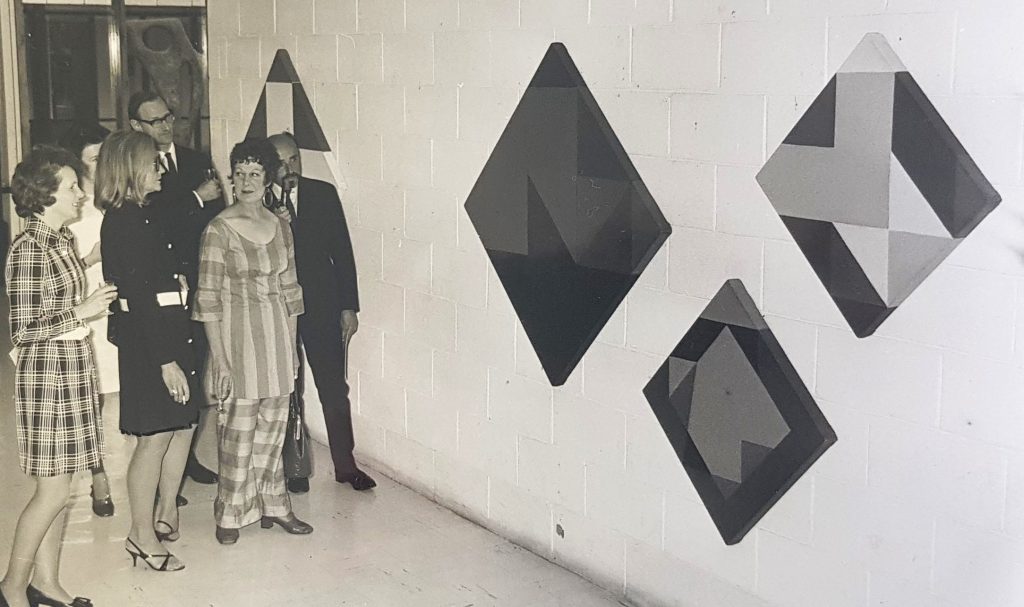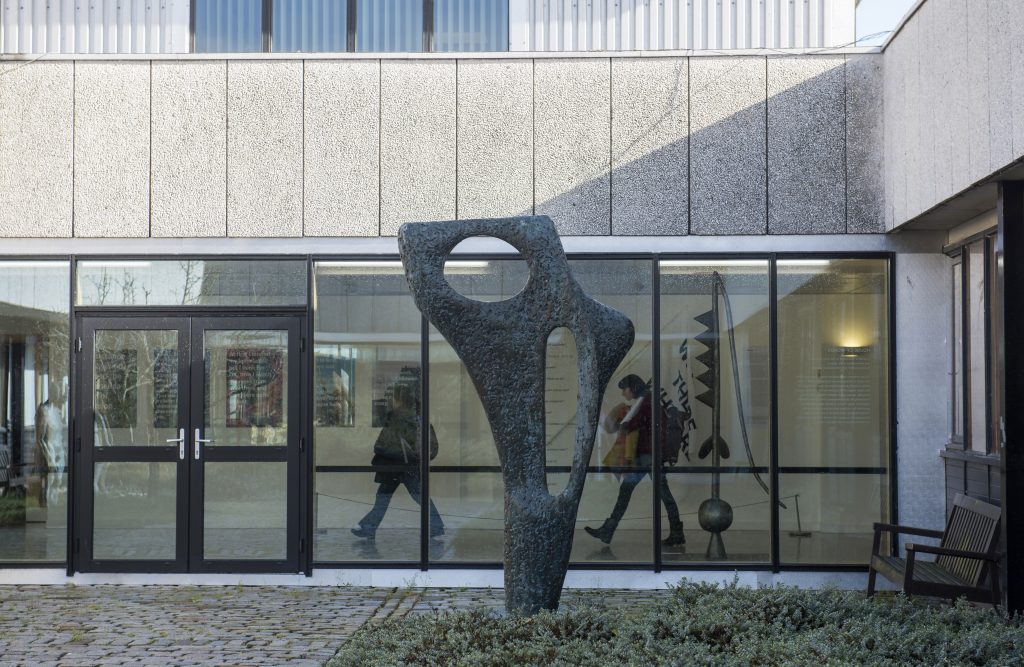Margaret Nairne Mellis (1914-2009) was a Scottish artist who trained at Edinburgh College of Art (1930-34), and was the first of a group to move to the Cornish coastal town of St Ives. The town went on to become home to an influential artist’s colony during the middle decades of the 20th Century. Later, Mellis became a friend of the first Art Curator at Stirling Matilda Hall (nee Mitchell), and exhibited in the Pathfoot Building in 1970, soon after the University opened. Matilda remembers that Mellis was highly organised. ‘Margaret knew exactly where every work was to be placed’. Although no pictures were purchased from this exhibition for the Collection at the time, Matilda herself was a collector of Mellis’s work and has recently very generously donated this painting. It is presented in memory of Matilda’s own time at Stirling and also in memory of her late husband Douglas Hall, first Keeper of the Scottish National Gallery of Modern Art, who played a pivotal role in the development of the Art Collection.
Mellis’s name is often mentioned in connection with artists represented in the Art Collection here at Stirling because of their links with her, and with St Ives during the Second World War. The photograph at the top shows her (in the striped trouser suit and hooped earrings) at the opening of her Pathfoot exhibition, and through the window behind, Barbara Hepworth’s sculpture Figure (Archaean) can be glimpsed in the courtyard (where it still stands today, as shown below).
In August 1939 as war threatened, Barbara Hepworth took her four young children to stay with her friend Margaret Mellis who had just moved to St Ives with her first husband Adrian Stokes (an art critic). Hepworth stayed several months with Mellis, and would remain in St Ives for the rest of her life. The sculpture above was created by Hepworth in the late 1950s, and can be seen in the photograph below, which shows Hepworth with the work in her studio garden in St Ives.
Wilhelmina Barns-Graham arrived in St Ives in March 1940 on a travel grant from Edinburgh College of Art, unable to venture further afield due to the war. She too had been drawn there by Mellis, who was a college friend from her time at Edinburgh College of Art.
During the war Mellis, surrounded by artists and one of the youngest of the group, was influenced by Ben Nicholson (Hepworth’s partner) and Naum Gabo and for a time adopted a Constructivist style, working in relief and collage. Mellis had a child in late 1940, and she and Hepworth would have had their hands full with domestic duties in the midst of the increasing privations of the war years. They both tried hard to keep their artistic practice going with limited resources and time. An example of Mellis’s work from that period is ‘Collage with Red Triangle ii’ (1940) which is now held at the V&A.
Another visitor to St Ives was Victor Pasmore (1908-1998). He had taught Mellis in the realist style at the Euston Road School, just prior to the war, but in St Ives was also influenced by Ben Nicolson. Pasmore subsequently moved into abstraction and formed part of a small group known during the 1950s as the Constructionists along with Mary Martin and her husband Kenneth. In the late 60s Mary Martin was commissioned by the University of Stirling to provide a major ‘Wall Construction‘ for the Pathfoot Building and Margaret Mellis would doubtless have seen this important work in its original Dining Room location on her visit to Pathfoot in 1970 (pictured below).

on the Dining Room wall in the Pathfoot Building.
After the war St Ives flourished with many other artists visiting and residing there, but Mellis had moved on, leaving abruptly when her marriage failed. Patrick Heron introduced Mellis to Francis Davison whom she married in 1948.

After two years in France they lived in Walberswick, then had a smallholding near Diss in Norfolk for 25 years. At first after she left St Ives, Mellis returned to representational painting, but by the mid 50s her work was becoming increasingly abstract. Just a few months after Mellis’s exhibition at Stirling, Davison also exhibited here (in January 1971, within the Macrobert Arts Centre with its purpose-built gallery). According to an obituarist, Mellis and Davison ‘journeyed into abstraction along personal but parallel routes’.

By the time this photograph was taken, Mellis was in her 50s
Miss Mellis sees her work as being on one of the few logical paths open to abstract painters today. She has said: ‘My reason for painting large is to make the colour do all the work. But I also wanted to find a way to make small paintings as significant through colour as large paintings. I discovered that by using a shape or perhaps two (in thickness) with the colours from which the painting was to be made, I could make the colour work extra hard and in some way compensate for the small size. Like building flats instead of spreading all over the ground. Although not flat, these works are not reliefs. The colours at full strength are turned into ‘colour’. All my paintings are colour structures’.
Margaret Mellis quoted in the exhibition catalogue Summer 1970
In 1976 after a move to Southwold, Mellis began to create driftwood sculptures, and this became her central practice. In later life she was a mentor to a teenage Damien Hirst
Read more about Margaret Mellis:
An article about Mellis in St Ives click here
An obituary of Margaret Mellis
For images of all Margaret Mellis works in public collections in the UK click here
Postscript
Incidentally, another person of interest in the photograph of the exhibition launch in 1970 is the man to the right of the group, standing slightly behind Mellis. He was Otto Newman, an Austrian, who at 16 had escaped dramatically from the Nazis on Kristallnacht, finally managed to reach London where, after the war, he first started a business, and later, at the age of 40, trained in Sociology at the London School of Economics. His first post was at the newly founded University of Stirling, where he stayed three years. His wife, June Pattenden, a fashion designer, stands to the other side of Mellis. Click here for an obituary about Otto Newman.



